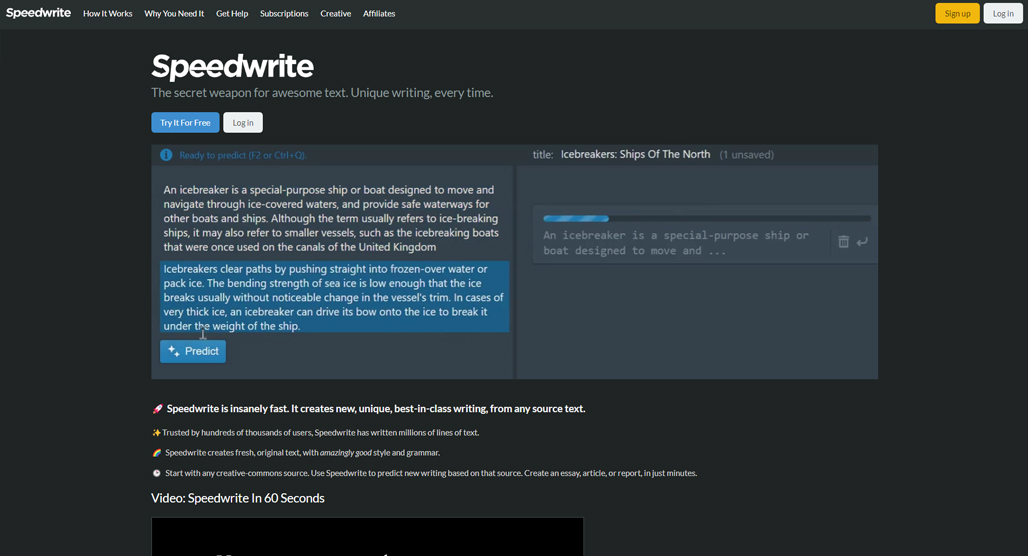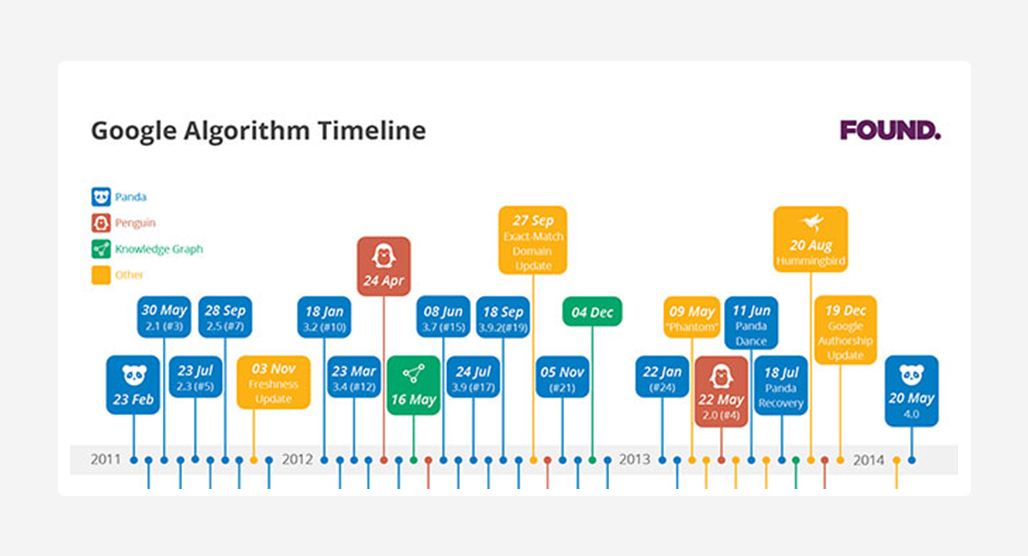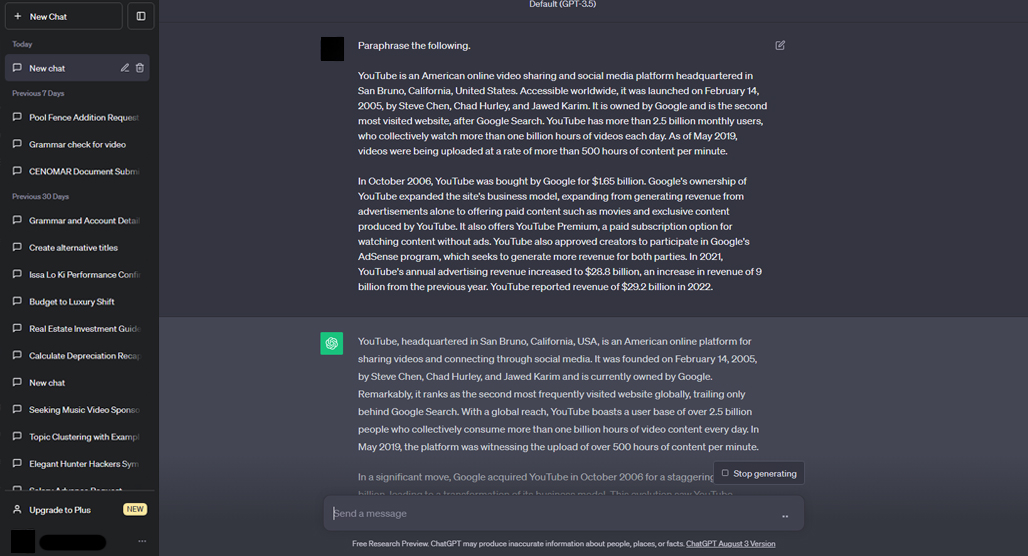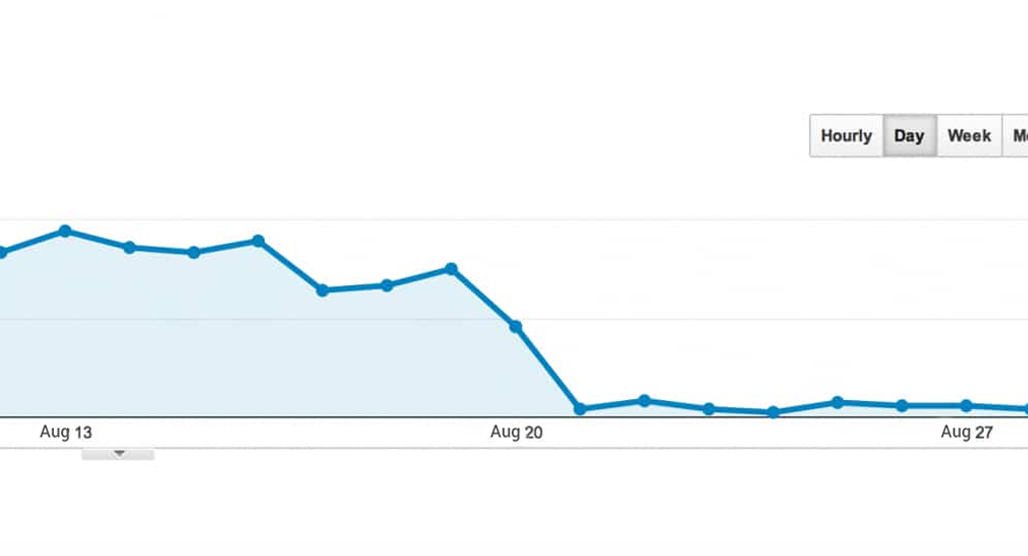Speedwrite: Is It SEO Friendly or a Recipe for Disaster?

Speedwrite is an AI content writing platform, in a broad sense similar to something like Jasper or ChatGPT, but a little different under the hood.
It’s also on the older side of “AI” platforms out there – having existed since before ChatGPT’s latest incarnations – but there’s a good reason for that.
Speedwrite is getting some attention, particularly on TikTok, as a way to streamline content production. The question is, is it an acceptable tool or a recipe for disaster?
Let’s dig in!
What is Speedwrite?
Speedwrite is a content production platform, an AI writer, and a content spinner. It claims to be many things, including “the secret weapon for awesome text,” but they don’t really make it clear what they are. They have a whole lot of copy on their homepage about how they can generate unique text, how tools like ChatGPT are worse in every way, and so on, but once you dig in a bit, you really have to ask yourself a few questions.
Why are they using more memes than explanations?
What’s really going on under the hood?
Well, you can try it for yourself, or you can read through their page on “how it works” (which is really just operation instructions, not a glimpse under the hood), or you can read on.
How Does Speedwrite Work?
On a purely mechanical level, Speedwrite is easy to use. All you do is copy text from a given source into their interface, highlight a section you want spun out into something unique for you, and click the “predict” button. This generates a roughly equivalent passage.
Here’s an example taken directly from their website.
First, the input. They claim this was generated by an “AI-Assisted Writer,” but their screenshot is directly from ChatGPT.
“Glacier National Park is a stunning natural wonder located in the state of Montana in the United States. The park is renowned for its magnificent glaciers, alpine meadows, and rugged peaks that reach up to 10,000 feet. It was established as a national park in 1910 and is considered to be one of the most beautiful and picturesque parks in the country.”
Two things about this:
- First, while it’s technically correct, basic, and just fine, it’s also not really unique. You can find numerous examples that have at least 50% match to this passage online.
- Second, it was presumably generated from ChatGPT with the prompt “Write an essay about Glacier National Park,” which, as anyone who has used an LLM can attest, is a very basic prompt that is going to generate very generic content.
Speedwrite claims they can generate unique content based on something as simple as this prompt input just by clicking their Predict button. They even have a demonstration. Here are two of the four results it generates.
“Situated in Montana, the magnificent Glacier National Park is a unique natural wonder that features numerous spectacular glaciers and alpine meadows. It was established in 1910 as a national park. It is regarded as one of the most scenic and beautiful parks in the country.”
And:
“The park, which is located in Montana, features numerous rugged peaks and magnificent glaciers that can reach up to 10,000 feet. Established in 1910, it is regarded as one of the country’s most beautiful and unique national parks.”
Immediately, you can notice a few things. All three of these passages are, effectively, identical. They all use specific phrases and words, like the descriptors magnificent, rugged, and scenic. They have identical facts expressed in the same way, and while they shuffle the word order, it’s substantially similar.
It’s no wonder that their homepage tells you to start with a Creative Commons source, and their examples all copy from Wikipedia; it’s not actually unique at all.
This leads me to two discussion points: the difference between spinners and large language models and what “uniqueness” actually means. I’ll start with the second one first.
Uniqueness in SEO
Uniqueness is a much-vaunted attribute for content online because Google has pushed for unique content. But, to understand what Google actually means by uniqueness, you need to know the history of why Google cares about it and how they evaluate it.
A long, long time ago, back before 2011, the internet looked a lot different. Many people today don’t remember it, and it would be… actually, kind of distressingly familiar to a lot of us.
See, the internet was reaching a crisis point. Way back in the 90s, the internet was swiftly growing, and there needed to be some way to find new things without just relying on word of mouth and advertising. Google was launched in 1998 as a search engine. It would create a vast index of the entire internet (or as much as it could) and allow you to search for anything you wanted in that index.
This kicked off the arms race that rages even today.
On one hand, Google and other search engines wanted to be useful to people. After all, without being useful, they couldn’t make money. So, they tried to provide results that people would want. That meant, in the late 90s, basically just showing content based on keywords. Later, they introduced ways to rank and weight those results based on their reputation and quality, measured with things like backlinks and PageRank.
In 2011, Google was losing the arms race. If you did a search for pretty much anything, the first 10, 20, and sometimes even 100 results would have identical content. Different websites, different domains, word-for-word identical information on the page, except maybe a call-to-action link or a different city name for a local service. It sucked! It made finding anything at all a massive chore.
2011 was when Google released their Panda update, which destroyed thin content and copied, duplicate, or non-unique content. It launched a million freelance writer careers, a thousand businesses offering article spinners, and a huge new emphasis on unique content.
So, how does Google actually measure uniqueness? Hint: it’s not comparing text and evaluating how much of it is identical. It goes much, much deeper than that.
Google puts a lot of math, science, and linguistics into their algorithm. They use things like semantic search, where they try to extract not just the words being used but the meaning behind those words. That’s why you can often find search results for a query you make that don’t actually use any of the words in your query unless you use quotes. Older versions used algorithms like TF-IDF, but Google has moved past that algorithm and to more sophisticated things.
This is also part of why plagiarism detectors and uniqueness detectors are different. Copyscape and its ilk will tell you if something is copied word-for-word from a source, and while that is part of uniqueness, it’s not all Google cares about.
Uniqueness also means the uniqueness of the way points and data are arranged, the arguments being made, the presentation of details, and so very much more than raw text.
That’s why when Speedwrite tells me that those examples above are unique writing that Google has never seen before, I just have to laugh. Sure, it’s not a 1:1 copy, but it’s close enough.
And trust me, Google has been fighting article spinners since far earlier than the current AI trends.
Spinners Vs. LLMs
On the surface, something like an article spinner and something like ChatGPT are largely the same. They work very differently, though, both under the hood and in terms of the results they give you.
Spinners are, at their core, a way to substitute and reorganize words and phrases to create something that is technically unique, even if it contains 100% of the same information and points.
A very simple example would be a sentence like this:
- “Writing that Google has never seen before.”
A spin version would be:
- “Content that Google hasn’t viewed previously.”
Substitution of words and phrases is pretty much the simplest possible way to spin a piece of writing into something that ostensibly is new.
Speedwrite is doing exactly that. It’s a little deeper – it doesn’t just swap words for synonyms; it reorganizes sentences and the like – but it’s still, basically, just a content spinner.
A large language model like ChatGPT is much, much larger and more sophisticated. In addition to doing something akin to spinning, it’s generating new text based on a huge database of data it has been trained on. That training is essentially a very complex map of how words usually fit together so that when you ask it to generate content based on some kind of words or phrases, it can do that based on common ways those words and phrases are used together.
I’m being very simplistic, but that’s because this is really not an evaluation of LLMs or AI. As much as Speedwrite wants to convince you it’s an AI, it’s not. It’s really just a spinner.
What are the Red Flags for Speedwrite?
I’ve already mentioned one red flag for Speedwrite: it telling you to use Creative Commons content as a source. After all, you can’t violate copyrights using content if that content isn’t protected.
Second, I really just don’t trust services that layer their homepage with memes rather than any useful information.
Third, they spent a lot of time trying to convince you that their competition, like ChatGPT, is bad. Now, I don’t disagree – using an LLM to generate content is generally not a good idea – but any business that has to resort to attacking popular competition on their homepage doesn’t have much to go on.
It’s also ironic to me that they claim anyone using the same tool will get the same results and that theirs is somehow better when, well, look at those examples up top again. It’s the same stuff. Real “pot calling the kettle black” hours here.
I will say that Speedwrite dunks on ChatGPT for “having NO knowledge of [the subject] at all!” That’s true since ChatGPT doesn’t know things, but it’s not the same kind of problem they’re presenting it as.
Finally, they tell you to fix errors in the output because they know it can make the same mistakes they insult their competition for making. It’s just covering their butts.
Is Speedwrite Safe for SEO?
Maybe, maybe not.
Here’s the thing: Speedwrite is doing the same thing that many freelance writers do: synthesizing information found from other sources into a technically unique passage of its own.
The difference is that humans can read information from half a dozen sources, gain an understanding of what those sources say, and write their own version that is completely unique. There’s no near-1:1 comparison like there is on the examples Speedwrite gives throughout their site.
Now, if you look around the internet today, you’ll see that a lot of the results you find are basically regurgitating the same things as other, more authoritative sites. There’s still original content being created, but it’s rarer and harder to find. Remember how I said that the days of 2011 are coming around again? We’re at a crossroads, and Google will have to make a decision soon enough.
Is Using Speedwrite a Good Idea?
I’m pretty cynical about hastily written content and wary of the risks associated with AI-generated content. As an SEO-minded individual, I acknowledge that I may not be the ideal target audience for Speedwrite.
With that said, I don’t think I would use Speedwrite. It might not be an immediate disaster like some of the more obvious article spinners, and it’s certainly not as bad as just copying content, but it’s a far cry from something as original as GPT, let alone human-created content.
Of course, the pricing doesn’t help. $20 per month gets you 6,000 predictions per month. A single prediction is each time you click the button. This post you’re reading now is something like 50 paragraphs. It’s probably enough for most small-scale blogs, but you can chew through it surprisingly quickly if you don’t like the initial output.
I doubt Speedwrite is useful enough yet, honestly. You need to find good source content, copy it, spin it, edit it, and fix it, and all that does is give you a spun article with no unique value. It’s not good enough, not when something like Jasper or GPT is right there, and I don’t even recommend using those without a lot of care.
Have you tried Speedwrite? If so, let me know about it in the comments. I’m always open to being proven wrong, but I’m pretty skeptical here.
Leave a Comment
Fine-tuned for competitive creators
Topicfinder is designed by a content marketing agency that writes hundreds of longform articles every month and competes at the highest level. It’s tailor-built for competitive content teams, marketers, and businesses.
Get Started










